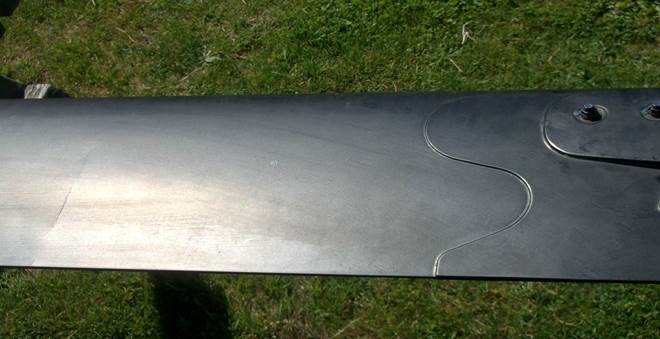· Hughes 369D/E/FF/500/600N fitted with MDHI part number blades;
· Hughes 369FF/500/600N fitted with P/N 500P2300-501 blades;
· Kawasaki-Hughes 369D fitted with MDHI or Kawasaki part number blades;
· Kawasaki-Hughes 369D fitted with Helicopter Technology Company part number blades that have been fitted in accordance with a local modification;
· Hughes 369A/D/E/H/HE/HM/HS fitted with P/N 500P2100-BSC, 500P2100-101 or 500P2100-301 blades.
See Aircraft Models and Blades Affected below for additional details.
The objective of this CAN is to highlight to operators the importance of performing torque event (TE) inspections correctly and to provide guidance on the inspection requirements.
Recently, the CAA received a defect notification from a pilot that had identified a large crack during a TE inspection on a Hughes 369E helicopter main rotor blade (see below).
.
|


Underside of 369E Main Rotor Blade P/N 500P2100-101, S/N C670, TTIS 1398 hrs, 9,800 TEs
MDHI Maintenance Manuals define a torque event as:
· The transition to a hover from forward flight.
· Any external lift operation.
NOTE: An external lift can either be on the cargo hook, external hoist or in external baskets. external lift recorded as two (2) TEs ( pick-up and drop-off). Hover taxi with no external load will typically result in no TEs.
TE inspections are required to be performed every 35 flight hours or 200 TEs after accumulation of 750 flight hours and 13,720 TE on the following aircraft models / blade part numbers:
(a) Hughes 369D/E/FF/500/600N fitted with MDHI part number blades – required by the Airworthiness Limitations ection of the Maintenance (Ref. CSP-HMI-2, Chapter 04-00-00, Note 37) in accordance with the Main Rotor Blade Torque Event Inspection
(b) Hughes 369FF/500/600N fitted with P/N 500P2300-501 blades – required by Helicopter Technology Company STC No. SR01050LA in accordance with the Main Rotor Blade Torque Event Inspection (Ref. CSP-HMI-2, 62-10-00 )
(c) Kawasaki-Hughes 369D fitted with MDHI or Kawasaki part number blades – required by Airworthiness Directive DCA/HU369/78A and the MDHI Maintenance Manual in accordance with the Main Rotor Blade Torque Event Inspection (Ref. Chapter 62-10-00 )
(d) Kawasaki-Hughes 369D fitted with Helicopter Technology Company part number blades that are fitted in accordance with a local modification – required by the relevant Helicopter Technology Company Blade Maintenance Manual in accordance with the Main Rotor Blade Torque Event Inspection (Ref. Chapter 62-10-00 )
Hughes 369A/D/E/H/HE/HM/HS fitted with P/N 500P2100-BSC, 500P2100-101 or 500P2100-301 blades
For (a) through ( ) above, pilots are
the torque event inspections that fall due between the scheduled 100 hour inspections provided the pilot receives adequate instruction by the LAME responsible for the aircraft, and certifies a release to service upon completion of each inspection
Persons that need to perform torque event inspections are required to have appropriate current technical data on hand i.e. a copy of the inspection procedure from the applicable MDHI Maintenance Manual or AD
Appropriate equipment must also be available each time a torque event inspection is performed. The inspection procedure requires use of:
· (At least) a 10X magnifying glass
· A bright light
· A method of lifting each blade being inspected off the droop stops while performing the inspection on the underside of the blade.
NOTE: This equipment is necessary to ensure that the inspections are performed adequately and any cracks are detected before catastrophic failure of the blade occurs.
It is recommended that pilots required to perform TE inspections familiarise themselves with this notice and the applicable technical data to ensure that they are appropriately qualified and knowledgeable to perform the inspections thoroughly and diligently.
If there is any doubt as to the requirements of the inspection or if the potential crack then an appropriately rated LAME should be consulted.
Enquires regarding Part 66 Maintenance Approvals should be made to:
Mark Price
Aviation Examiner, Maintenance Engineering
Email: pricem@caa.govt.nz
Phone: 04 560 9619
All other enquires regarding this CAN should be made to:
Jack Stanton
Team Leader Continuing Airworthiness
Email: stantonj@caa.govt.nz
Phone: 04 560 9664